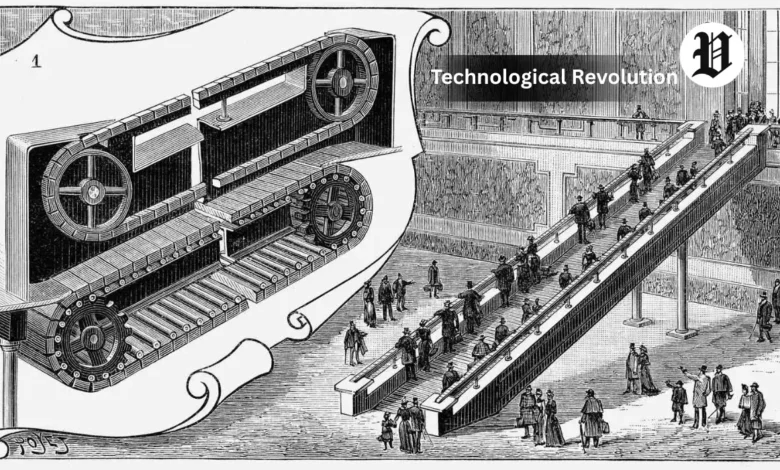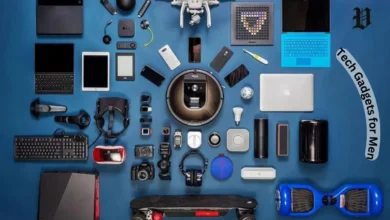Technological Revolution: How 1800s Tech Changed the World

Imagine yourself sewing every stitch of a shirt by hand, or waiting weeks for a letter to cross the country. Before the Industrial Revolution came along and turned everything upside down with technical developments in the industrial revolution, this was how things were. This age of advanced tools and techniques transformed sleeping small villages into lively factory centers, thereby setting the stage for the world you live in today.
Your work, transportation, even friendship communication with your friends were transformed by the industrial revolution and technology together. Steam engines chugged; telegraphs hummed; Electric lights pushed the darkness away. Let’s examine the technology of the 1800s and see how one brilliant idea at a time formed the modern world.
What Was This Whole Technological Revolution?
So, what’s the deal with the technological revolution? It’s when new technologies of the industrial revolution burst in, making work faster and life bigger. They called it the technical revolution, and it kicked off in the late 1700s, then roared through the 1800s, thanks to folks who looked at a problem and thought, “I’ll build a machine for that.”
Historians say it started around 1760 in Britain, but if you’re wondering when was the technological revolution, it’s tied to the Industrial Revolution’s two big waves. The first was all about textiles and iron; the second, in the late 1800s, brought steel, electricity, and chemicals. These changes grew from stuff prior to the industrial revolution, like hand tools and small workshops, and turned into a world run by machines.
Put simply, what is technological revolution? It’s when machines started doing the hard work, making everything quicker and stronger. From Britain’s mills to America’s factories, this revolution changed how people lived all over.
Inventions That Blew Minds
The technological advancements in industrial revolution changed industries with tools that felt like magic back then. Steam power was the big deal, letting factories run without rivers or horses. James Watt messed around with the steam engine, making it tougher and ready for all kinds of jobs.
These advances in technology during the industrial revolution didn’t just stay in factories. Railroads stretched across fields and mountains, making far-off places feel like next door. By the mid-1800s, steam locomotives were hauling goods and people at speeds no one could’ve imagined, sparking trade and city growth.
Then there was communication. The telegraph, a real star of technological advances in the industrial revolution, sent messages across oceans in minutes. Samuel Morse’s code turned wires into a fast lane for news and business, connecting folks in ways they’d never been before.
Tech That Changed How You Lived
Technology during the industrial revolution wasn’t just about noisy machines—it changed your everyday life. Down South, how did technological developments affect agriculture in the south? Tools like plows and reapers cranked out more crops, feeding growing cities and letting farmers send workers to factories.
Up North, it was a whole different vibe. How did technological developments and industry affect the northern economy? Textile mills and ironworks popped up everywhere, pulling in workers and turning small towns into busy cities. This showed how technology and revolution went hand in hand, with machines driving big changes in how you lived.
Energy got a big boost, too. The industrial revolution technological advances in coal mining kept steam engines running, powering trains and factories. These technological advances during the industrial revolution set the stage for later stuff, like the car you might drive today.
Inventions That Stole the Show
The 1800s were packed with big ideas. Inventions in the 1800s went from handy tools to life-changing gadgets. Elias Howe’s 1846 sewing machine made clothes quicker and cheaper, so regular folks could afford new outfits without going broke.
Among 1800’s inventions, Alexander Graham Bell’s 1876 telephone was a total game-changer. It let you talk to someone miles away, shaking up businesses and friendships. Imagine trying to plan a party without a quick call—that’s what Bell’s invention replaced.
Other inventions of the 1800s, like Thomas Edison’s 1879 light bulb, stretched workdays into the night. Factories could keep going, making more stuff faster. These inventions made in the 1800s weren’t just one-offs; they piled up, each one pushing things forward.
People also see: Ray-Ban Meta Smart Glasses: The Ultimate Blend of Style, Function, and Tech
A Look at the Decades
Let’s zoom in on the technology in the 1800s. Early on, Eli Whitney’s 1793 cotton gin sped up cotton processing, giving the textile industry a huge boost.
By the technology in the 1850s, railroads were everywhere. America’s transcontinental railway linked the East and West, making travel and trade way easier.
The 1880s technology brought electricity into homes. George Westinghouse’s alternating current system lit up streets and powered gadgets, changing how you lived after dark.
Technology in the 1890s rolled out the automobile. Karl Benz’s 1885 motorwagen turned into real vehicles, hinting at a future where everyone could drive.
1890 technology also included Wilhelm Röntgen’s 1895 X-rays, which changed medicine forever. These technology in 1890s breakthroughs wrapped up the century with a bang.
How New Tech Changed Industries
New technology of the industrial revolution, like the power loom, made weaving automatic, cutting costs and pumping out fabric. This new technology in the industrial revolution pushed hand weavers out but opened up tons of factory jobs.
What impact did technological advances have on industry? They made production massive. The 1856 Bessemer process churned out cheap steel for bridges, ships, and more.
Electricity took it to the next level. How did the invention of electricity impact industries? It powered assembly lines, making factories faster and safer than steam ever could.
What technology innovation most affected the american economy? Railroads, hands down—they tied markets together and fueled growth like nothing else.
The Big Picture of 19th Century Tech
The 19th century technology wasn’t just about factories. 19th century inventions like Louis Daguerre’s 1839 photography let you capture moments forever, changing how you see the world.
Technology 19th century also made medicine better—think anesthesia in the 1840s, making surgeries pain-free. These inventions of the 19th century made life easier in big and small ways.
Inventions in the 19th century, like the 1868 typewriter, sped up office work, setting the stage for the computers you use today.
A Quick Glance at the Big Inventions
Here’s a table of major technological advancements of the industrial revolution:
| Invention | Inventor | Year | Impact |
| Steam Engine | James Watt | 1769 | Powered factories and locomotives, enabling industrial age technology. |
| Cotton Gin | Eli Whitney | 1793 | Boosted cotton production, influencing southern agriculture. |
| Telegraph | Samuel Morse | 1837 | Revolutionized communication with instant messaging. |
| Sewing Machine | Elias Howe | 1846 | Automated clothing manufacturing, reducing costs. |
| Bessemer Process | Henry Bessemer | 1856 | Made steel affordable for construction and machinery. |
| Telephone | Alexander Graham Bell | 1876 | Connected people voice-to-voice over distances. |
| Light Bulb | Thomas Edison | 1879 | Extended productive hours with artificial light. |
| Automobile | Karl Benz | 1885 | Laid groundwork for personal transportation. |
This table shows how technological advances of the industrial revolution kept things moving.
Early Sparks and Lasting Changes
Early industrial revolution technologies focused on textiles. James Hargreaves’ 1764 spinning jenny spun multiple threads at once, speeding things up.
These led to industrial revolution technological innovations, like Eli Whitney’s interchangeable parts, which made manufacturing consistent and efficient.
How did new technologies affect all americans? They pulled you into cities, made goods cheaper, but also brought tough factory conditions and long hours.
Globally, continuities in the global economy from 1900 to present trace back to these roots, with machines driving trade across the world.
The Tech Revolution Kept Rolling
The revolution of technology didn’t stop in 1900. Technology of 1900 brought early radios, keeping the Industrial Age’s spirit alive.
1900 technology led into the 20th century, with the Wright brothers’ 1903 airplane taking off.
Technology in 1900 carried the 1800s’ momentum forward.
Compare that to 1700 technology—just windmills and hand tools. The jump to 1800 technology was huge.
Technology in 1700 couldn’t touch technology in the 1700s, which started leaning toward steam.
1700s technology set the stage, but the 1800s lit the fire.
How 1800s Tech Shapes Your Life Today
Technology from 1800s still shows up in your phone, your car, your world. All steam technologies evolved into the turbines powering today’s plants.
Explain how technology shaped economic production over time: It went from farms to factories, then to the digital world you’re in now.
What era saw rapid growth due to steam engine-powered machinery? The Victorian era, mid-1800s, when steam was king.
What technology brought about advances in the british textile industry? Water frames and power looms turned weaving into a machine-driven process.
These list advances in technology that helped begin industrialization, like better iron smelting and canals for moving goods.
Stepping Into the 20th Century
As the 1800s ended, 1910 technology brought Henry Ford’s assembly lines, pumping out cars like never before.
Technology of the 1900s built on 1800s roots, with electricity speeding everything up.
1900’s technology was a bridge, but its heart was still in the Industrial Revolution.
Want to know more about how cities grew back then? Check out our post on urban growth during industrialization.
The technological revolutions keep going, from digital to AI, but they all carry the 1800s’ spark of invention.
Your world was built on these bold steps. What’s the next big thing you’ll help create?
FAQ
What is the world history definition of improved techniques and technology?
In world history, improved techniques and technology mean inventions that make work faster and easier, like machines replacing handwork in the Industrial Revolution.
How did the industrial revolution and technology intersect?
The industrial revolution and technology came together when inventions like the steam engine turned farming economies into industrial powerhouses.
What defined technology in the 1800s?
Technology in the 1800s was all about steam power, railroads, and early electricity, pushing society toward faster production and travel.
How do technology and revolution connect in historical contexts?
Technology and revolution connect when inventions spark big changes, like machines driving new economies in the Industrial Revolution.
What were the key technological advancements in the industrial revolution?
Key technological advancements in the industrial revolution included the spinning jenny, power loom, and iron refining, boosting textile and metal industries.
What examples highlight technology of the 1800s?
Technology of the 1800s featured the telegraph for quick communication and the sewing machine for faster manufacturing.
Which technology from 1800s still influences us today?
Technology from 1800s, like railroads and electric lights, laid the groundwork for modern transport and power systems.
What was the technology of 1800s in transportation?
Technology of 1800s in transportation meant steam locomotives and ships, linking markets and people faster than ever.
How did industrial revolution new technology change manufacturing?
Industrial revolution new technology, like steam engines and assembly lines, turned small workshops into huge factories.
What technological advancements in industrial revolution boosted agriculture?
Technological advancements in industrial revolution, like mechanical reapers, ramped up farm output, feeding growing cities.




